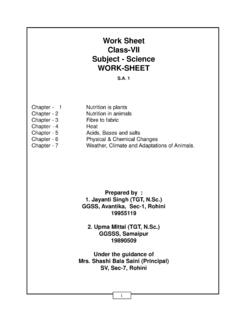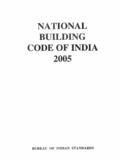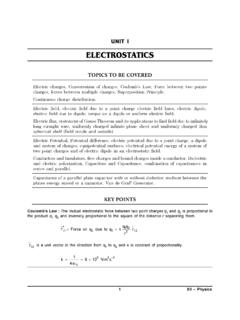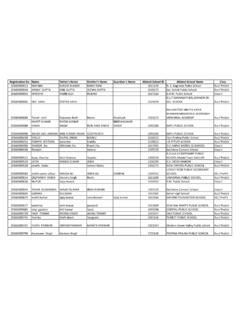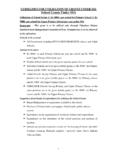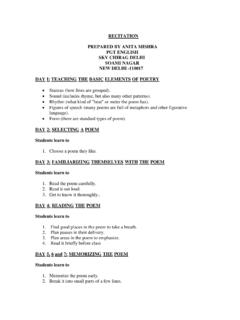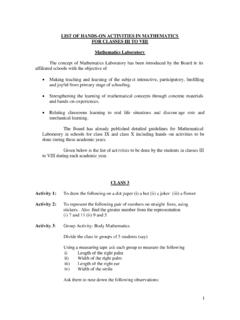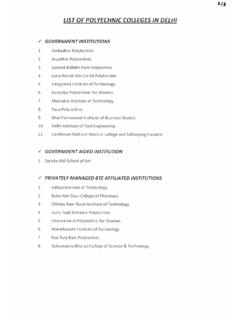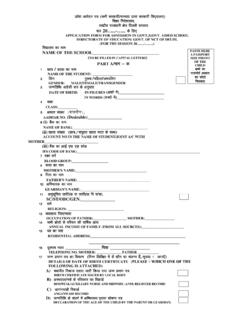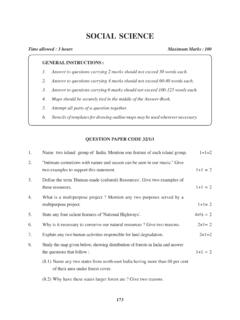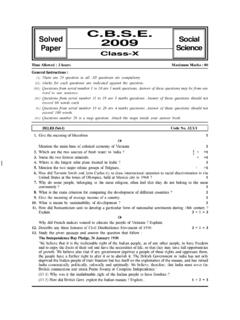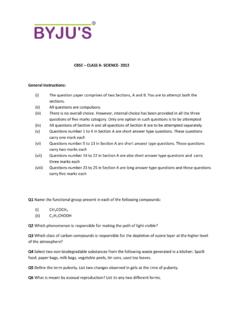Transcription of X SESSION - edudel.nic.in
1 ANNUAL CURRICULUM PLANNER CLASS : X SESSION : 2018-19 social SCIENCE ( cbse SUBJECT Code No. 087) COURSE STRUCTURE CLASS X Time: 3 Hrs. Max. Marks: 80 NO. Units Marks Periods I India and the Contemporary World - II 20 60 II Contemporary India - II 20 55 III Democratic Politics II 20 50 IV Economics 20 50 TOTAL 80 215 ASSESSMENT SCHEDULE/FORMAT The Assessment Format & weightage of marks for classes X will be as under: CLASS ASSESSMENT I* ASSESSMENT II* NOTE BOOK SUBMISSION SUBJECT ENRICHMENT ACTIVITY CASE TOTAL X 5 5 5 5 80 100 NOTE:OUT OF THREE MARKS BEST TWO WILL BE CONSIDERED FOR INTERNAL ASSESSMENT * 10 MARKS Notebook Submission (05 Marks):Notebook submission as a part of Internal Assessment is aimed at enhancing seriousness of students towards preparing notes on the topics being taught in the classroom as well as the assignments.
2 This alsoaddresses the critical aspect of regularity, punctuality, neatness and notebook upkeep. Subject Enrichment Activities (05 Marks):These are subject specific application activities aimed at enrichment of the understanding and skill development. These activities are to be recorded internally by the concerned subject teachers. Guidelines issued by cbse for classes IX & X to be followed by all the Govt & Govt Aided schools. TERM WISE SYLLABUS ( SESSION 2018-2019) FIRST /MID TERM ( APRIL 2018 TO SEPTEMBER 2018 ) CONTENT HISTORY : India and the Contemporary World II In Sub-unit students are required to choose any two themes. In that sub-unit, theme 3 is compulsory and for second theme students are required to choose any one from the first two themes.
3 In Sub-units and students are required to choose any one theme from each. Thus all students are required to study four themes in all. Sub-unit : Events and processes: Any one from 1 and 2 of the following themes 1. The Rise of Nationalism in Europe: . (Chapter 1) (a) The growth of nationalism in Europe after the 1830s. (b) The ideas of Giuseppe Mazzini, etc. (c) General characteristics of the movements in Poland, Hungary, Italy, Germany and Greece. OR 2. The Nationalist Movement in Indo - China: . (Chapter 2) (a)Factors Leading to Growth of Nationalism in Indo-China (a)French colonialism in Indo-China. (b) Phases of struggle against the French. (c) The ideas of Phan Chu Trinh, Phan Boi Chau, HO Chi Minh (d) The Second World War and the liberation struggle.
4 (e) America and the Vietnam war The theme will discuss the forms in which nationalism developed along with the formation of nation states in Europe in the post-1830 period. Discuss the relationship/difference between European nationalism and anti-colonial nationalisms. Point to the way the idea of the Formath required nation states became generalized in Europe and elsewhere. Discuss the difference between French colonialism in Indo-China and British colonialism in India. Outline the different stages of the anti-imperialist struggle in IndoChina. Familiarize the students with the differences between nationalist movements in Indo China and India. Discuss the characteristics of Indian nationalism through a case study of Civil Disobedience Movement.
5 Analyze the nature of the diverse social movements of the time. 16 3. Nationalism in India: (Chapter3) (a)Impact of First world war,Khilafat, NonCooperation and Differing Strands within the Movement. (b) Salt Satyagraha. (c) Movements of peasants, workers, tribals. (d) Limits of Civil Disobedience. (e) The Sense of Collective Belonging GEOGRAPHY Contemporary India II and Development: . (Chapter 1) Types - natural and human; Need for resource planning, natural resources, land as a resource, soil types and distribution; changing land-use pattern; land degradation and conservation measures 3. Water Resources: (Chapter 3) Sources, distribution, utilisation, multi-purpose projects, water scarcity, need for conservation and management, rainwater harvesting.
6 (One case study to be introduced) 4. Agriculture: (Chapter 4) Types of farming, major crops, cropping pattern, technological and institutional reforms; their impact; contribution of Agriculture to national economy-employment and output. Note: Content of pg no. 44-47 of NCERT Textbook is to be deleted. 5. Minerals and Energy Resources: (Chapter 5) Types of minerals, distribution (Note: on map only) use and economic importance of minerals, conservation, types of power resources: conventional and nonconventional, distribution and utilization, and conservation. POLITICAL SCIENCE : Democratic Politics II Sharing (Chapter 1) Why and how is power shared in democracies? How has federal division of power in India helped national unity?
7 2. Federalism: (Chapter 2) To what extent has decentralisation achieved this objective? How does democracy accommodate different social groups Democracy and Diversity : (Chapter 3 ) Are divisions inherent to the working of democracy? , Religion and Caste: (Chapter 4) What has been the effect of caste on politics and of politics on caste? How has the gender division shaped politics? How do communal divisions affect democracy? Economics : (Chapter 1) The traditional notion of development; National Income and Percapita Income. Growth of National Income - critical appraisal of existing development indicators (PCI, IMR, SR and other income and health indicators) The need for health and educational development; Human Development Indicators (in simple and brief as a holistic measure of development.)
8 Ofthe Indian Economy(Chapter 2) :*Sectors of Economic Activities; Historical change in sectors; Rising importance of tertiary sector; Employment Generation; Division of Sectors- Organised and Unorganised; Protective measures for unorganised sector workers. and Credit: (Chapter 3) Role of money in an economy: Formal and Informal financial institutions for Savings andCredit-General Introduction; Select one formal institution such as a nationalized commercial bank and a few informal institutions; Local money lenders, landlords, chit funds and private finance companies. (Note : Ch-3 will also be evaluated in theory) Revision of syllabus for Mid -Term Exam/periodic Assessment 1 SECOND/FINAL TERM ( OCTOBER 2018 TO FEBRUARY 2019 ) HISTORY : India and the Contemporary World II Sub-unit : Livelihoods, Economies and Societies: Any one of the following themes: 4.
9 The making of a Global World: . (Chapter 4) (a) The Pre-modern world (b) The Nineteenth Century Global Economy (Colonialism) (c) The Inter war Economy (Great Depression) (d) Rebuilding the World Economy OR 5. The Age of Industrialization : . (Chapter 5) (a) Proto-industrialization and pace of industrial change (b) Life of workers (c) Industrialization in the colonies (d) Early Entrepreneurs & Workers (e) The Peculiarities of Industrial Growth (f) Market for Goods OR 6. Work, Life & Leisure : . (Chapter 6) (a) Development of modern cities due to Industrialization in London & Bombay (b) Housing and Land Reclamation (c) social Changes in the cities (d) Cities and the challenge of the Environment Sub-unit : Everyday Life, Culture and Politics (Any one of the following themes): 7.
10 Print Culture and the Modern World: . (Chapter 7) (a) The history of print in Europe. (b) The growth of press in nineteenth century India. (c) Relationship between print culture, public debate and politics OR , Society and History: (Chapter 8) (a) Emergence of the novel as a genre in the west. (b) The relationship between the novel and changes in modern society. (c) Early novels in nineteenth century India. (d) A study of two or three major writers GEOGRAPHY: Contemporary India - II Industries: (Chapter 6) Types, spatial distribution (Note: on map only) contribution of industries to the national economy, industrial pollution and degradation of environment, measures to control degradation. Note : Content mentioned on page no.
